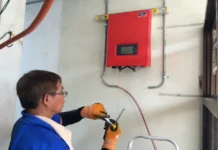Are you wondering about the mystery behind the operation of an inverter? No worries, this PowerVersity guide focuses on an inverter’s operation – how does an inverter work.
Additionally, we will go over the different types of inverters, the best ones available, and a few frequently asked questions that can assist in making the best choice.
Learn how an inverter operates and why you should get one by reading about it.
We were all confined to our homes and other living areas during the COVID-19 pandemic. An interruption of electricity during the work-from-home period may result in significant harm.
Powerversity has a way to prevent any harm to your personal or professional life. All you need to frighten away all these troublesome elements is an appropriate inverter.
These troublesome elements might be the heat, the humidity, or the unsteady Internet caused by voltage changes.
Before you buy an inverter, make sure to read this article for all of the useful information. This comprehensive guide focuses on how an inverter works, its many forms, and the best available on the market.
What is even an inverter? Do you know?. Oh yeah!! You are about to ask, right?
Okay, let’s do justice to that question.
What Is An inverter?
An inverter is a piece of stand-alone equipment that transforms a direct current voltage into an alternating current voltage.
The inverter converts direct current to alternating voltage by transforming the energy stored in DC sources such as batteries and rectifiers.
The inverter’s batteries store energy in the form of direct current, but the household appliances we use require alternating current, which is how inverters function.
In the event of a power outage or other emergency, the inverter may be utilized to power our appliances.
Now let us briefly talk about the types of inverters that are available.
How Does An Inverter Work: Types Of Inverter
There are mostly three (3) types of inverters. These include:
Sine Wave Inverter
You may obtain a sine wave from a generator and, often, from your local power provider.
This is because sine waves are naturally formed by rotating AC gear and are responsible for their creation.
The main benefit of a sine wave inverter is that all commercially available equipment is sine wave-designed. This ensures that the machinery will perform in accordance with its maximum capabilities.
Only sine wave electricity will allow some items, including microwaves and motors, to operate at maximum capacity.
A sine wave is necessary for several devices to function at all, including some battery chargers, light dimmers, and bread machines.
The cost of sine wave inverters is usually higher—by up to three times.
Square Wave Inverter
These inverters produce a square-shaped waveform, as the name implies.
In comparison to inverters that use modified sine waveforms and pure sine waveforms, square wave inverters are less efficient.
If you simply require a few items to be connected to the inverter, this inverter is perfect for you. These are inexpensive and easily accessible on the market.
However, using a square waveform inverter can be challenging because these devices have a propensity for noise.
There aren’t many, but square wave inverters are the most affordable.
Simple devices having universal motors, like tools, can be easily operated by a square wave inverter, but not many other items. Nowadays, square wave inverters are seldom found.
Modified Sine Wave Inverter
A modified sine wave inverter’s waveform resembles a square wave more, but with an additional step or two.
With most devices, a modified sine wave inverter will function without issue, though with some, its efficiency or power may be diminished.
Due to the inverter’s poorer efficiency, motors like those in pumps, fans, and refrigerators will require more electricity. Most motors will require 20% more power overall.
This is due to the fact that a sizable portion of modified sine waves have frequencies greater than 60 Hz, making them unusable for motors.
Certain fluorescent lights won’t operate as brightly, and others might buzz or make annoying humming noises.
Electronic timers and/or digital clocks in appliances frequently don’t work properly.
Many appliances acquire their timing from line power, which essentially divides the 60 Hz (cycles per second) into 1 per second or whatever is required.
Clocks and timers may run quicker or not function at all because the modified sine wave is louder and rougher than a pure sine wave.
Clocks can run quickly because they also include certain wave components that are not 60 Hz.
Appliances with electrical temperature controls frequently malfunction, including things like bread machines and light dimmers.
The most typical is that items like variable-speed drills only have two speeds—on and off.
Now that you are aware of the different types of inverters, let’s talk about how an inverter works step-by-step.
Thereafter, we will address the factors to take into account while selecting the best inverters available.
How Does An Inverter Work?
The function of an inverter is to regulate the power supply’s voltage and frequency. Moreover, it controls the motors’ rotational speeds in home appliances and commercial machines.
Note that the converter circuit of an inverter transforms the alternating current (AC) from the power source into direct current (DC).
In addition, the inverter circuit converts the transformed direct current (DC) back into alternating current (AC). They work as a single entity.
The converter circuit starts by continuously converting alternating electricity to direct current. This is known as rectification. The direction and size of the wave vary often with alternating current since it is a sine wave.
As a consequence, electricity in the forward direction is converted into direct current using a diode, a semiconductor device, but not in the opposite direction.
A positive peak is produced by the diode because only the forward direction of direct current can flow power through it.
However, the other half of the cycle will be wasted if it fails to pass the peak in the opposite direction.
The bridge-like form of the diode’s construction enables it to pass the negative peak in a forward direction.
Full-wave rectification is the term used to describe this process since it modifies both the forward and negative wave peaks.
On the other hand, because rippling voltage fluctuations and traces of alternating current are still present, full-wave rectification is unable to generate a smooth waveform.
The capacitor is periodically charged and discharged to remove these impurities, gradually modifying the waveform to resemble direct current.
After that, alternating current with a variable voltage and frequency is produced by the inverter circuit.
To produce pulse waves of different lengths, the DC/AC conversion mechanism modifies the ON/OFF intervals of power transistors like the “IGBT (Insulated Gate Bipolar Transistor).”
They are then combined to create a pseudo-sine wave. This process is referred to as “Pulse Width Modulation (PWM).”
The computer automatically regulates the pulse width. A PWM feature is pre-installed on some of the specialized one-chip processors that regulate the motor.
This enables you to regulate the motor’s rotation speed by only giving the appropriate parameters and by producing pseudo-sine waves with a range of frequencies.
How Does An Inverter Work: Factors To Consider When Choosing An Inverter
There are various things you should take into account when buying an inverter; here are some of the most crucial ones:
Determine and calculate your power needs
This is the first item to consider before purchasing an inverter for your house. It is usually helpful to get a general estimate of your entire power usage.
Your power need is the total amount of electricity required to run all of the appliances you wish to keep functioning during a power outage.
If you have numerous units of the same appliance (for example, four fans), increase the power use of that device by the number of units.
Assume you have four fans, each of which consumes 75 watts of power. You also have three tube lights, three CFL bulbs, two LED bulbs, and a television, all of which consume 50, 30, 8, and 120 watts, respectively.
Your power needs are as follows: 475 + 350 + 330 + 28 + 120 = 676 watts.
Choose a battery size
Although choosing the right battery size is crucial, this factor will assist you in identifying the ideal inverter for your needs. The battery size is measured in Ah.
Knowing how inverters function and determining the duration for which you’ll require backup from the inverter are both necessary for determining the optimal battery size.
The wattage of your inverter multiplied by the number of hours you want to use it will help you choose the battery size.
After multiplication, the result will be expressed in VAh (battery voltage x number of batteries x capacity of batteries (AH)).
However, since the essential inverter battery capacity is 12 V, you must decrease the computed result by 12.
Depending on your power requirements and preferences, you may choose the perfect inverter size. You should always use a larger capacity if the identical battery capacity inverter is not available.
The variety of batteries is one of the key considerations you should make when choosing an inverter.
Let us discuss the main three types of batteries.
Lead-Acid Batteries
Lead-acid batteries are often utilized. The lead-acid batteries are portable, simple to replenish, and they do generate the necessary current.
With routine maintenance, these batteries can last for up to three to four years.
Tubular Batteries
The most commonly utilized type of inverter battery is tubular. These are renowned for their high effectiveness and up to an 8-year operational life.
Tubular batteries are pricey but remain a common option due to their many advantages and attributes.
Maintenance-free Batteries
The sealed acid maintenance-free batteries have a lifespan of 4-5 years and don’t need to have their electrolyte levels checked or maintained.
Recognize the differences between an inverter and a home UPS
In terms of functioning, a home UPS is equivalent to an inverter. Since both devices are used to change direct current to alternating current,.
Hence, it is utilized as a backup alternative to creating electricity. However, the key difference between an inverter and a UPS (uninterrupted power supply) is the battery size.
For a UPS, depending on the size, you might not be able to power it with a high voltage divide. Meanwhile, for the inverter, you will be able to power all your devices with both low and high voltage.
Determine which appliances can be powered by an inverter.
Refrigerators and air conditioners can be powered by an inverter.
However, the motors of the aforementioned appliances are outfitted with compressors that require massive amounts of current, particularly when starting up.
To accommodate such high-current-drawing appliances, it is better to use inverters with high VA values and sizes, or inverters specifically built to accommodate refrigerators and air conditioners.
Featured in Safety
Given how crucial safety is, you shouldn’t purchase an inverter without first examining its safety features.
Knowing an inverter has over-voltage protection, surge protection, and over-heating protection is worth paying more for.
Hence, this protects you, downstream electronics, and upstream sources, is useful knowledge that comes with the ability to monitor voltage.
How Does An Inverter Work?: Pros And Cons Of Using An Inverter
Just as we know, everything that has an advantage also has a disadvantage.
In this section, we are going to be looking at the pros and cons of using an inverter. Without further ado, let’s get to it.
Pros Of Using An Inverter
Smart Features
As we know, technology is advancing faster and better than before. This applies to almost all gadgets, if not all, and inverters are no exception.
There are now inverters that have smart features like WiFi and Bluetooth connectivity, all for your convenience.
WiFi and Bluetooth connectivity as features for your inverter make you connect your mobile device to monitor your inverter, which in turn, makes checking the readings, charging time, battery, and so on very easy.
Suitable Even For High Power Requirements
It is easy to work at home with an inverter that has a high Ah (Ampere Hour) rating, which is the inverter’s capacity.
This means the higher the Ah, the more gadgets you will be able to power during a power outage.
Inverters are now made to handle very high power requirements, which adds another advantage to their long list.
Quiet Operation
This is a great advantage, especially if you have to work from home and you have a power outage.
Inverters run a very quiet operation; however, not all inverters are quiet, as we all know that not all inverters were made the same way.
Using an inverter that carries out its operation quietly means that you can have your meetings, conferences, and calls without any noise or background disturbance.
UPS Mode
A good inverter for your home should have UPS mode. This ensures that u have a fast change of current from the main power to the backup power.
Furthermore, this UPS mode ensures and helps to protect all your data and make the switch instantly.
Even more, this feature is very important as it makes your work from home easier by instantly increasing your inverter’s capacity.
How Does An Inverter Work: Maintenance Of The Inverter
Maintaining inverters does not come with any sort of issue, as they are very simple and easy to maintain.
All you need to do is monitor the electric parts due to the heat it produce.
Furthermore, because of that heat, it is advised to place it (both the inverter and the battery/batteries) in a well-ventilated area.
Even more, you also need to make sure the airflow around your inverter is not covered or blocked, as it helps cool the device.
Other advantages include;
- Changes in voltage may be made in an energy-efficient manner.
- Even more, it can increase or decrease voltage.
- Further, it creates an electrical barrier between the input and the output.
- Also, an inverter is capable of converting a DC source into an AC voltage.
- Further, an inverter can be used to tame erratic changes in input voltage.
- Lastly, an inverter is capable of converting a 60 Hz supply to 50 Hz or the other way around.
Cons Of Using An Inverter
- If one panel is damaged or shaded, the production volume drops overall.
- There is no capability to see each panel separately
- If your solar panels are angled differently, that is not ideal.
- Increasing power requirements are more challenging and can need the installation of a second central inverter.
- An inverter costs more than average to purchase and set up, but the expense is well worth it. They are also more expensive than even generators.
How Does An Inverter Work: Specifications Of The 5 Best Selected Inverter
| Product Name | Dimensions | Item Weight | Wattage | Volts AC | Volts DC | Frequency |
| Renogy 1000W Pure Sine Wave, Off-Grid Solar Power Inverter | 12.9 x 6.8 x 3.3 inches | 6.0 pounds | 1000W | 120V | 12V | 60Hz |
| EPREC 600W Grid Tie Solar Inverter | 11.89 x 8.31 x 4.69 inches | 3.74 pounds | 600W | 90V-140V | 11V-32V | 48Hz ~ 62Hz |
| LiSos 1000w on Grid Tie Pure Sine Wave Power Inverter | 16.42 x 10 x 5.47 inches | 8.94 pounds | 1000W | 90-130V | 11-28V | 46-65Hz |
| Y&H 1000W Grid Tie Inverter | 13 x 6 x 3 inches | 5.38 pounds | 1000W | 90V-140V | 20V-45V | 48Hz ~ 62Hz |
| Y&H 2000W 2KW Grid Tie Inverter | 21.2 x 12.2 x 6.1 inches | 14.22 pounds | 2000W | 240V(185-265V) | 60-110V | 46-65Hz |
How Does An Inverter Work?: Frequently Asked Questions

By transforming the energy held in dc sources like batteries and rectifiers, the inverter converts direct current into alternating voltage.
This is how inverters function: the batteries within them retain electricity in the form of direct current, whereas the household appliances we use require alternating current.
The inversion is powered by a 12-volt battery or many batteries connected in parallel. The battery has to be charged periodically since the inverter draws power from the battery to provide us with power when there is no electrical source.
The battery’s consumption as well as the load of the attached appliances have an impact. If your 150 Ah battery has been completely charged, it should operate under a 400-watt bulb load for about 3 hours.
If the load or device wattage is decreased, the backup will function better.
Yes, you may utilize solar panels and inverters without battery storage provided you are linked to the electrical grid.
It’s crucial to keep in mind, though, that grid-tied solar systems are often turned off during blackouts to protect utility personnel from being electrocuted.
Your inverter battery’s main enemies are rust, corrosion, and dryness.
The amount of current flowing to and from the battery is decreased by terminal rusting. Because of the constrained current flow, batteries charge slowly, which shortens their lifespan.
How Does An Inverter Work: My Final Thoughts
I believe that this article has made you understand the working principle of an inverter.
Furthermore, if you are looking to purchase one of the best inverters, a table containing the 5 best has been laid out for you in this article.
If you considered this post useful, please review it using the “Leave a Reply” box at the bottom of this page.
You might be interested in reading more articles like this one. Please visit the following pages:
5 Best Cloud Storage Devices For Your Home




